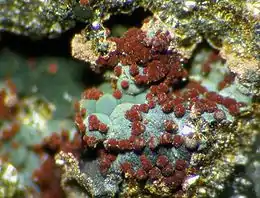| Robertsite | |
|---|---|
 Robertsite spheres (reddish brown) on beraunite | |
| General | |
| Category | Phosphate minerals |
| Formula (repeating unit) | Ca3(Mn3+)4[(OH)3| (PO4)2]2·3H2O |
| IMA symbol | Rbt[1] |
| Strunz classification | 8.DH.30 |
| Dana classification | 42.08.04.02 Mitridatite group |
| Crystal system | Monoclinic |
| Crystal class | Prismatic (2/m) (same H-M symbol) |
| Space group | A2/a |
| Unit cell | a = 17.36 Å, b = 19.53 Å c = 11.30 Å; β = 96.0°; Z = 12 |
| Identification | |
| Color | Red, red-brown, deep red, bronzy brown, black |
| Crystal habit | laty to wedge-shaped, pseudorhombohedral crystals; fibrous, in botryoidal to feathery aggregates |
| Twinning | Common perpendicular to {100} |
| Cleavage | Very good {100} |
| Fracture | Micaceous |
| Mohs scale hardness | 3+1⁄2 |
| Luster | Vitreous to resinous or waxy |
| Streak | Chocolate-brown |
| Diaphaneity | Translucent |
| Specific gravity | 3.13 - 3.17 |
| Optical properties | Biaxial (-) |
| Refractive index | nα = 1.775 nβ = 1.820 nγ = 1.820 |
| Birefringence | δ = 0.045 |
| Pleochroism | Strong, X pale red to pink Y,Z deep red brown |
| 2V angle | Measured: 8° |
| References | [2][3][4] |
Robertsite, Ca3(Mn3+)4[(OH)3| (PO4)2]2·3(H2O) (alternatively formulated Ca2(Mn3(PO4)3O2)(H2O)3), is a secondary phosphate mineral named for Willard Lincoln Roberts (1923–1987), mineralogist and professor at South Dakota School of Mines in Rapid City, South Dakota.
The type locality for Robertsite is the Tip Top mine, Custer County, South Dakota, US. Robertsite occurs at the Tip Top Mine as minute crystal aggregates and crusts found on quartz associated with triphylite. It is a dark reddish brown to black monoclinic mineral.
It occurs as a secondary mineral in pegmatite. It is also reported from the Khoa Rang Kai phosphate deposit, Chiang Mai, Thailand in a limestone guano deposit.[3] It is associated with rockbridgeite, ferrisicklerite, leucophosphite, jahnsite, montgomeryite, collinsite and hureaulite in the type locality. In the guano deposit it occurs with carbonate-fluorapatite, calcite, dolomite, quartz and clay minerals.[3] In the Omo Valley of Ethiopia it occurs with mitridatite associated with fossil fish in Pliocene/Pleistocene lake sediments.[5]
Recently, in an exploration conducted by the Italian La Venta Geographical Association, confirmed the existence of Robertsite in the Puerto Princesa Subterranean River National Park, located about 50 kilometres (31 mi) north of the city center of Puerto Princesa, Palawan, Philippines.[6][7]
- Mitridatite group:
- Arseniosiderite-mitridatite series:[8]
- Ca2(Fe3+)3[(O)2|(AsO4)3]·3H2O
- to
- Ca2(Fe3+)3[(O)2|(PO4)3]·3H2O
- Arseniosiderite-robertsite series:[9]
- Ca2(Fe3+)3[(O)2|(AsO4)3]·3H2O
- to
- Ca3(Mn3+)4[(OH)3|(PO4)2]2·3H2O
- Arseniosiderite-mitridatite series:[8]
References
- ↑ Warr, L.N. (2021). "IMA–CNMNC approved mineral symbols". Mineralogical Magazine. 85 (3): 291–320. Bibcode:2021MinM...85..291W. doi:10.1180/mgm.2021.43. S2CID 235729616.
- ↑ Robertsite: Mindat.org
- 1 2 3 Handbook of Mineralogy
- ↑ Webmineral data
- ↑ Mindat location data
- ↑ Mendoza, Shielo. "Why Puerto Princesa's underground river deserves to win". Yahoo! Southeast Asia Newsroom. Retrieved November 10, 2011.
- ↑ Villamente, JIng. "$5B income seen from Wonders of Nature win". The Manila Times.net. Archived from the original on 13 November 2011. Retrieved 10 November 2011.
- ↑ Mindat Arseniosiderite-Mitridatite Series
- ↑ Mindat Arseniosiderite-Robertsite Series
- Frank C. Hawthorne (1998). "Structure and chemistry of phosphate minerals" (abstract page). Mineralogical Magazine. 62 (2): 141–164. Bibcode:1998MinM...62..141H. doi:10.1180/002646198547512. S2CID 38295867.
- Moore, P.B. (1974). "Isotypy of robertsite, mitridatite and arseniosiderite". Am. Mineral. B59: 55–59.
- Andrade, M. B., Morrison, S. M., Di Domizio, A. J., Feinglos, M. N., & Downs, R. T. (2012). Robertsite, Ca2MnIII3O2 (PO4) 3.3 H2O. Acta Crystallographica Section E: Structure Reports Online, 68(10), i74-i75.doi:10.1107/S160053681203735X